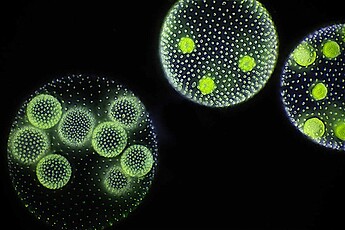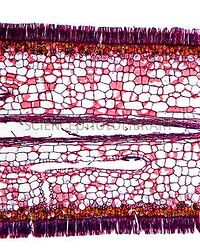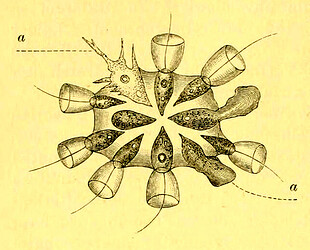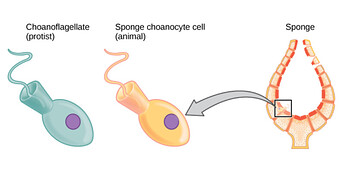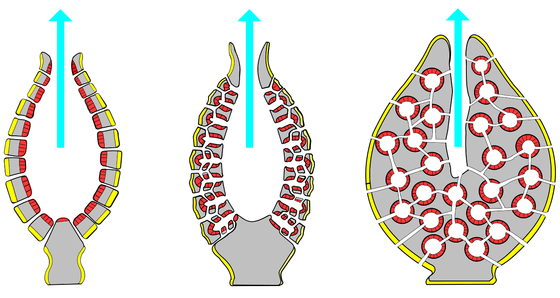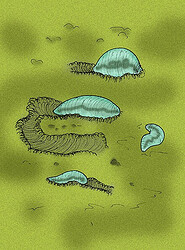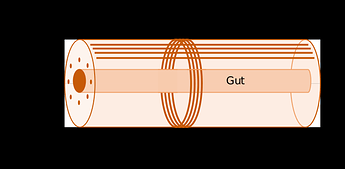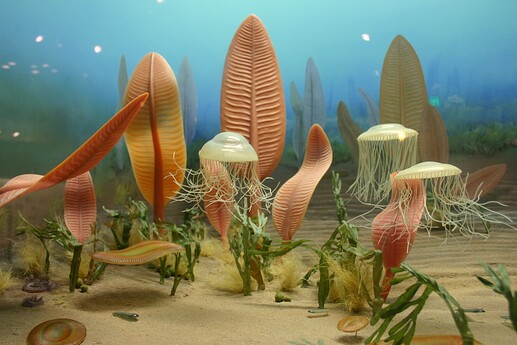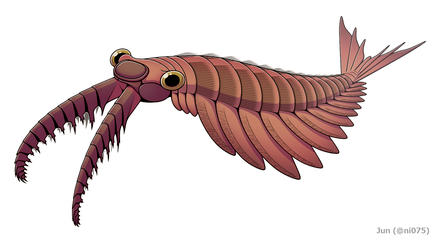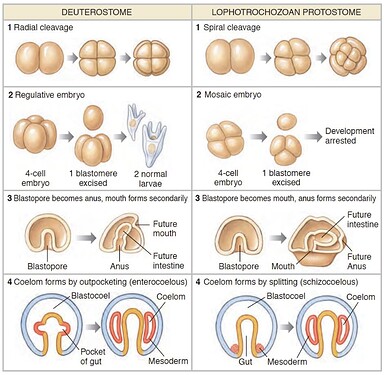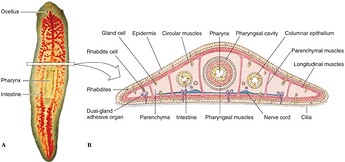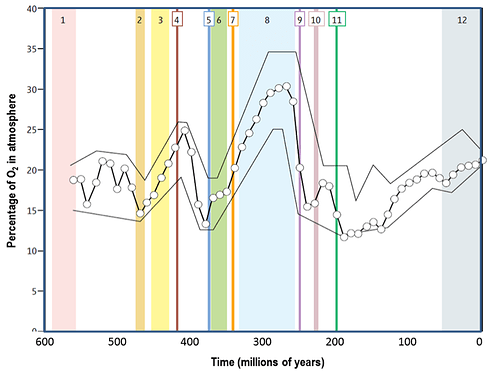Hello everyone!
I here want to talk today in honor of the release of Thrive Eggs (early multicellular stage), I want to talk about a concept that seems quite important and not much has been written: how such a creature eats and what does it eat.
And more importantly - what effect do such creatures have on the environment.
I’m not going to talk about how such a transition goes from the unicellular to the multicellular stage, since it has been talked about in the past and I am not going to focus specifically on that.
Instead, I will talk about one of the most important things in the early stages - nutrition.
How does a primitive multicellular creature feed in general and what are the steps to transition from a “filter” to a true “predator”?
These are the issues I want to deal with.
On this subject we will compare here with the knowledge we know about the beginning of multicellular beings.
But before that - a few points:
- My English its not the best and if there any missleading info or translate error, pls tell me about that.
- This is a more scientific focus than from a game perspective, but it can give a concept on how such a game can go through in the game.
- I have assigned this topic to a future game, but if it feels like it does not suit you, tell me.
- Unlike previous times, I do not have / have found a link to previous articles related to this topic that fits what I am writing, so I will try to explain this whole topic in depth.
From the first multicellular first feeding path
First of all - the term “first multicellular” I speak here is of animals, as there is an unclear area who is really the first:
For example there is evidence of the multicellular formation of cyanobacteria from 3.5 billion years ago. So I’m going to leave the one created first aside (I put a link to an article on this topic):
But in general, multicellular organisms evolved at least 25 times, but for a strange reason - multicellular animals evolved only once compared to something like mushrooms whose multicellular version evolved 3 times and Slime mold 7 times. Which makes this question even bigger - why is this so?
No one still knows, but in my opinion, it just happened, no more. It’s luck or probability that it’s so happened, but the effect of animals on everyone’s evolution is particularly great for one reason: the ability to move long distances.
No other multicellular known to us is capable of moving long distances in a short time on its own. This has given a huge advantage to such creatures that are able to move independently as they can look for food instead of waiting for it.
But this was not the case at first, and many groups of animals do not move at all, like corals, several types of worms and sponges.
And here is our starting point on the subject.
What is the first multicellular feeding pathway?
The answer to this is under a number of factors:
1. What is this multicellular cell?
If it’s autotropic, it does not need a way to feed from the outside, since it produces food from the outside, then development it will focus instead on ways to absorb its necessary ingredients from the outside, which is not something that requires a complex system.
For example: Volvox, a multicellular globule of green algae, which consists of a variable number of cells and is relatively young in terms of multicellular complexity:
even today, seem like complex algae like the brown algae in the microscope, are not very complex:
If this multi-cell is unable to create food for itself, it must find another way to eat or find food.
And to eat something, there are 2 ways to do it:
“External digestion” and “Internal digestion”
For external digestion, similar to the way fungi eat, enzymes, toxins or proteins are released that are intended to collect or break down nutrients so that the cell could easily absorb them through phagocytosis and phytocytosis. The downside to this is that materials can get lost and drift away from the cell itself, losing energy and nutrients it needs. This way is very similar to the way bacteria eat / feed.
For internal digestion, the cell swallows a small creature (unicellular) in phagocytosis and by way of release of proteins and enzymes, it breaks down the creature and absorbs the substances from it. This way is effective in terms of absorption efficiency of nutrients without fear of losing on the buoyancy since the whole process is inside the body, and with it, absorbed directly. But this way requires more energy to get food: it has to swallow it, and it requires quite a bit of energy and has a risk of danger from the prey itself.
An example of such a creature is Choanoflagellate, the closest genetic class to animals, and some show signs of multicellular aggregation:
2. Activity
We know 2 types of activity: sessile and active (there are both those in the middle and those that are parasites, but it does not change the definition of these)
Sessile are feeding behaviors in which the creature waits for food to approach it. This is a way that saves a lot of energy, as it does not waste energy and time looking for food. But at the same time, it’s a less effective way in terms of how much food he obtains.
Active is a feeding behavior in which the creature actively seeks out its food. This is an action that takes a lot of energy, but his compensation is that he is able to obtain food that Sessile is unable to reach, thus giving him an advantage as he has more access to food and is less dependent on luck and environment to find food, as it can move along with food.
Autotrophic creatures tend to be sessile as opposed to a heterotrophic who is unable to produce his food.
3. Size
Size has a very important effect on what foods it can access and how it serves them. And it is also able to work the other way around.
By the laws of nature, there is a great tendency to create life to evolve into a great creature because it has the significant advantage of repeating itself at many points here: large creatures are not easily preyed upon, which is probably why multicellular creatures were created in the first place. Because no one can devour you if they can not swallow you.
For more on this topic, you can find here:
And how does it move into the game?
From what I see, it does not require any change at all as it is contemporary since, contemporary behavior is correct or looking at the way the game is working now. I here do not know the plans (as of this writing), but at least in my opinion, that is the right direction.
But from this point on, things are going to get complicated.
From Sponges to Avalon Revolution
Once such a multicellular creature is created, with the right conditions, such as lack of competition and great access to food and a predation minority. He will continue to grow and evolve into a huge creature in relation to others. But with that, additional problems begin to form that come with size: it becomes too heavy for water to hold and support, and thus it begins to sink. The creature becomes too large for food to reach the cells in the form of a diffusion and actually starve them and the size rules change.
What are the solutions that such creatures have come up with?
We will leave aside the “cell specialization” which is another problem that for it to grow, it needs a way to reproduce and maintain this size (these are called gametes) and we will move on to the problem of getting enough food to sustain it.
It is inevitable that a creature needs to find a way to filter food efficiently, since now its food is too small for it to be devoured on the one hand, and on the other hand, too small for it to provide it.
And not to mention another way to transport food and oxygen deeper.
Some of the ways that solved this problem is to increase the surface area by folding so that all the cells had access to the things they wanted without sacrificing cells from the inside.
Another way they have found is in a larger investment of energy - active filtration.
A creature that does this is the first on our list of animals: sponges.
To summarize how he does this, here is a picture that explains this:
Through movement, they use to change the pressure differences of the water created by the motion to move water from one point to another. And what is in the water? Nutrients that the sponge needs. Following this the sponges were the first group of animals that were ever more successful, and their impact on the environment is another important one that helped these creatures survive the “Snowball Earth” era:
Later in another geological time, another way of obtaining food developed: active behavior. From sessile formations, after the nervous system and the esophagus evolved, through which they could put food indoors and eat there instead of filtering from the outside, a mutation was created with which they could use the soft body and nervous system, use for active movement, and swim farther and higher. From them arose the immense advantage of those who were glued to the ground, that they had access to food which was not previously accessible.
These are the jellyfish and the Cnidaria.
But to put it bluntly, filtration from water is not the only way a primary multicellular creature can obtain food during this period.
There is another way to get food, and it seems that a group that has developed a nervous system on its own (according to several theories), and specialized in getting this type of food - the biofilm/microbial mats layers.
Layers for those that contained large groups of bacteria of various types, lived in symbiosis with each other for subsistence.
These strata existed long ago, the earliest evidence of which existed 3.25 million years ago:
https://www.nature.com/articles/nrmicro821
But from this group, the animals that specialized in eating them, are the ones that led to the development of most of the groups of animals we know today: the bilaterian.
This group, whose earliest species called Ikaria Wariootia (560~550 mill B.C):
With This is a more active way of obtaining food: dragging on the bottom with muscle fibers and peeling the layer straight into a new way of inserting food: intestines/gut.
This way of internal digestion in this tube gives a great advantage over others like the sponges where the food enters from one point, and created from another point (the exception are flat worms. Which have only one opening, but are also the earliest creatures of this group, feel free to search in depth On them, but I do not intend to expand on them, as they are not so relevant to the current issue) and thus digested food does not mix with undigested food, saves energy and at the same time increases the consumption of food from which they receive.
These putative creatures first evolved in the “Avalon Explosion”.
“Avalon Explosion” is an explosion similar to the Cambrian explosion, but 15 million years earlier, which led to a huge increase in the variety of species and the emergence of various building plans. And this is also the first and most important point in the development of different feeding pathways, because from this point, the biofilm/ microbial mats layers began to disappear, and this is the turning point of the development of life in the Cambrian period.
From Worm world to the Cambrian explosion and the first predator
Shortly after the Avalon eruption, an eruption of a variety of bilaterian species also began to spread rapidly until the world was called the “worm world” at that time, where worm-like creatures such as ringworms began to appear. And with them, through the behavior of creating holes in the soil sediment where the microbial mats grow and changing the soil texture. As conditions change (in addition to other factors such as land disintegration and climatic conditions) an extinction bug has begun to form, more information can be found here:
Following these changes, macrobial mats and with it, their food almost completely disappeared.
Because of this, those who survived, had to find another source of food, and what other food source is better than another creature?
From this point, the first predators began to develop - those that fed on other creatures, and with it also began an arms race: creatures with armor, exoskeletons and shells (some have other use in the past but it later transform to use as defense vs predators) began to appear, and in order to make this adjustment, several important points began to develop:
- Complex Development of the Mouth and Cephalization- Before the jaw develops later, use muscle and mechanical pressure to try to break down tissues or fibers of other creatures, helping the development of predators (including plant eaters). head’s specialization in gathering information and collecting tenders of the nervous system (which later developed into the brain)
- Eyes - Eyes began to play a significant role in this period, and this is to see the environment, understand it and react accordingly, a key role in the predator-prey dynamics
- Swimming and impulse - One of the ways to get food or escape a predators is the development of swimming, which was previously in jellyfish, which were not predators before (as far as we know), but now it has started to develop in lots of other creatures. each one and his own way.
These effects were felt in the Cambrian explosion, with the rise of the first known super-predator - Anomalocaris, which has all the features presented here.
And from there only the species diversity began to behave and be adapted to prey-prey that were not in the periods before.
Having briefly explained the history of Pre-Cambrian prehistoric multicellular pathways, the big question I wrote remains:
How do we translate such a thing into a game?
First of all, we need to address this question:
What is the player’s desire to develop?
Does he want his creature to have no mouth at all, that he was dependent on the diffusion of the environment and his ability to absorb things?
We can give him the tools to do this, but we need to warn him that it limits the size he can or the energy he is able to create, both because of the need for oxygen and the creature’s ability to absorb food.
If he still wants to, things have to be adjusted for his style: does he want him to act like a jellyfish, or like a sponge? Or maybe even plant-like or mushroom-like?
If he wants his creature to be more active, we need to show him a primary food source, like macrobia mat at the bottom of the sea or maybe he will find a way to get it through active water filtration, like Annelida and from there jump into possible shapes when that food source runs out, it should give him Possibility and not prevent him from exploring options.
I imagine a window of options when certain conditions occur - perhaps because the oxygen levels have reached a level where it allows the formation of these organs, or it is possible to draw a virtual tube showing where the intestines pass. Or maybe try upgrading a particular organ by sitgmentation.
I think when you get to the real multicellular, you should add green layers at the beginning of the game that show there is a special food source for starters called Microbial mats that the player can collect at first, as his mouth is too weak, or alternatively, develop ways to filter water and get filtered food - passive or active, Everything is under his control and choice.
Consistent order should be in the player’s control, after all, I think the game’s ambition is that the game itself creates its alien biosphere, and with it, the other creatures move around it.
But I also think some of it was a nightmare of programming, but some can be ignored and it will not hurt the game, maybe like in the next section:
Developmental layers of the body adapted to animals - Side notes
For bilaterian have 3 layers of development and differentiation in the initial development of a fetus, unlike sponges and Cnidaria, they only have 2:
- Extoderm (epidermis) - the outer layer from which sensory systems develop, a source of the nervous system, cilia and body covering (and more)
- Endoderm (gastrodermis) - the inner layer from which the outer layer of the intestines, digestive cells and secretions, etc. are formed
- Mesoderm (mesothelium) - unique to the bilaterian, from which develops the cover layer for Coelom, muscle cells, gametes and of course, the organs in the body.
Out of the bilaterian, there are 2 classes:
Protostomia - a class in which the mouth is formed first and then, the anus.
Deuterostome - a class in which the mouth after it is formed becomes the anus and then forms another hole that becomes the mouth - this is the group to which vertebrates belong.
A table that show the deffrents:
The reason I explain this is because this thing was especially important in the functional development and differentiation of organs and parts of the body. It is important to know this if we want to translate it into a game since the organs exist only in the bilaterian (again, exceptionally it is flat worms, which have the middle layer, but no organs develop from there)
Oxygen as a motive for predation - Side note
It is important to remember that oxygen plays an important role in the formation of predators in the biosphere system. In the last periods I have described an increase in the concentration of oxygen in the atmosphere, and at the same time, also in the water (following this or together) and this contributed to the development of more active creatures which later, led to the formation of predators.
After all, movement consumes a lot of oxygen and energy to move the muscles or tissues needed.
(The level of O2 in the Cambrian explosion ~543 million years ago was a bit higher then today, and in Avalon explosion ~575 million years ago was lower then today, according to the graph, make the Oxygen an importen factor in the rise of predators )
But here I want to comment one more thing: In the beginning of multicellular development, there is evidence that at first there was still partial retention of anaerobic respiration, but over time, multicellularized specialized to use oxygen and now (except for one animal) they have become oxygen dependent:
Summary
- An abbreviated transition on life between the onset of multicellular (animal) emergence to the first super-predetor
- The impact of the environment on consumption
- Forms of eating and feeding, and how they are built for it
- General explanation of different types of animals
- An idea for the transformation of these themes into a game, in part or for the most part
Conclusions
I my opinion, its was importen to brine up the topic of feeding and nourishment in early life of earth, and because we try to make the game follow the overall idea of how early multicellular life use to eat, i did some resource to write here, i hope its give some aspect in that topic
thx for reading
